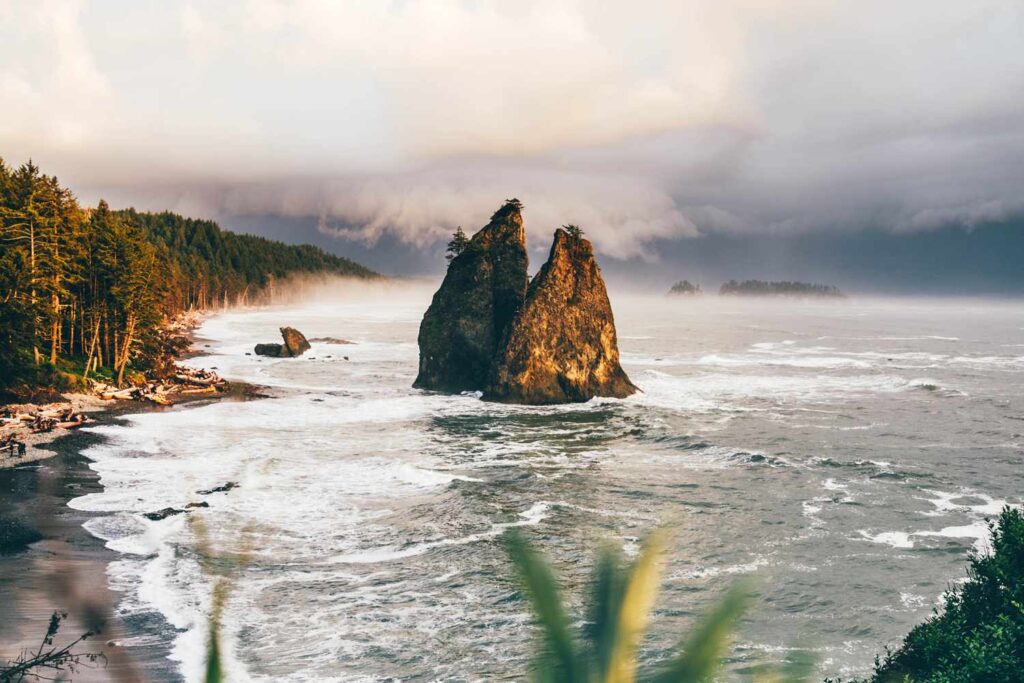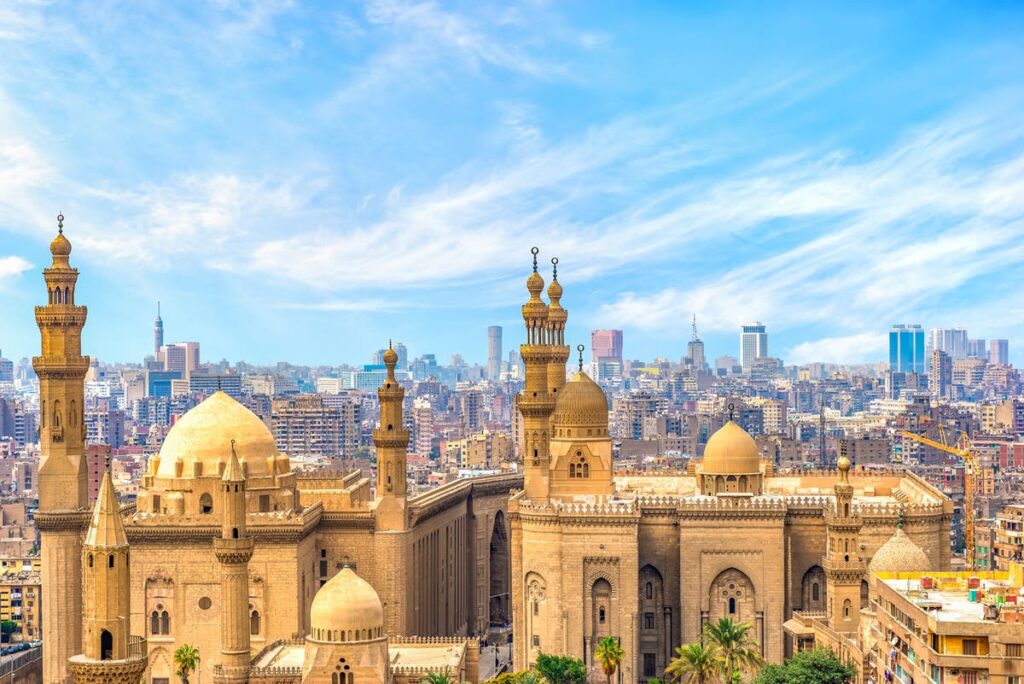:max_bytes(150000):strip_icc():format(jpeg)/TAL-lead-image-OLYMPICNP0425-3da51a8489fa4696a15299ab00ed8adf.jpg)
Top 5 Can’t Miss
- Walk through the moss-laden trails of the Hoh Rain Forest, marvel at the massive sea stacks of Rialto Beach, and take in sweeping summit views from Hurricane Ridge.
- Feast on local Salish Sea seafood outside the park at Salty Girls Seafood.
- Overnight in historic park hotels like the Lake Quinault Lodge deep within the misty, lush rainforest.
- Stay up late stargazing under unbelievable night skies.
- Explore nearby Washington destinations outside the park, such as Port Angeles, Cape Flattery, and Forks—yes, that place from Twilight.
On clear days, looking across the waters of Puget Sound from Seattle, it’s possible to see a wall of snaggle-toothed, snowcapped peaks looming along the skyline. Those distant summits are the Olympic Mountains, the towering heart of Olympic National Park.
Encompassing nearly a million acres on Washington’s Olympic Peninsula, Olympic National Park is, needless to say, big. Along with sheer size, the park—which was first designated a national monument in 1909 before becoming a national park in 1938—is home to a diverse set of ecosystems: glaciated mountains, a rugged Pacific coastline, alpine meadows, and one of North America’s few remaining temperate rainforests.
But along with all the traditional hallmarks of a national park visit—hiking, backpacking, climbing, kayaking, wildlife-watching—people are drawn to Olympic because it’s one of the quietest places in the country. Within the mossy depths of the Hoh Rain Forest, travelers can visit a place called the “One Square Inch of Silence” identified by nonprofit Quiet Parks International as the quietest place in the continental United States. With its lack of roads and overhead flight paths, most of Olympic offers respite from man-made noise.
“So many people come to Olympic looking for quiet,” says Matt Mikkelsen, chairperson and executive director of Wilderness Quiet Parks (which is part of Quiet Parks International). He captured film and audio for the organization during his time at Olympic. “It’s not a resource we talk about enough … silence is an indicator of the overall health of an ecosystem.”
Here’s what you need to know before planning a trip to Olympic National Park.
How to Get There
Zeb Andrews/Getty Images
While there are several smaller airports on the Olympic Peninsula, the nearest major airport is Seattle-Tacoma International Airport (SEA). From the Seattle area, you can drive south around Puget Sound via I-5 to reach the park—a roughly three-hour journey—but nothing beats traveling by ferry. Take one of Washington state’s car-friendly ferries across Elliot Bay to Bainbridge Island and follow state highways until you link up with Highway 101. The ferry-car route takes roughly the same amount of time, but makes for a more scenic experience, with chances to spot whales during the crossing. Alternatively, you could fly into Victoria International Airport (YYJ) on Canada’s Vancouver Island, and take the Black Ball Ferry Line to Port Angeles.
How to Get Around
Clocking in at nearly 1 million acres, Olympic National Park is vast, so a car is a must. With no roads directly crossing the park, you’ll use the Highway 101 perimeter road to get around, connecting to smaller routes that lead to trailheads, campgrounds, and lodgings. I recommend getting a rental car at Seattle-Tacoma International Airport or in peninsula towns like Port Angeles. The Clallam Transit System offers some regional bus routes and a seasonal shuttle to Hurricane Ridge.
Best Time To Visit
Anna Gorin/Getty Images
The best time to visit Olympic National Park is from June to August when there’s less rainfall, warm weather, and long summer days. However, it’s also when the park will be most crowded, so book hotels or campgrounds well in advance and visit popular spots like the Hoh Rain Forest early or later in the day to find more parking and fewer crowds.
However, Olympic is open year-round, with springtime wildflowers and whale-watching on the coast in May, and opportunities to see the salmon run in September and October. While some roads, lodges, and campgrounds will be closed in winter, other areas like Hurricane Ridge are open for snowshoeing and cross-country skiing. If you’re visiting during September and October, steer clear of elk due to the aggressive behavior rutting season can bring.
Best Places to Stay
Courtesy of Delaware North
Along with lodgings inside and outside its perimeter, Olympic National Park has 14 campgrounds scattered around the park. Type of camping (primitive versus RV-permitted), facilities, seasonal openings, and the number of sites vary by campground—reservations are required at some of the most popular ones like the Hoh Rain Forest Campground.
Kalaloch Lodge
Built in 1953 from wave-tossed driftwood, the historic Kalaloch Lodge sits between the forest and the sea at the southern end of Olympic’s oceanfront strand. Open year-round, you can choose among accommodations like rooms in the rustic main lodge, the stand-alone Seacrest House, or one of the private shoreline cabins. After walking along blustery beaches to stand before the Tree of Life (a tree root cave), retreat to fire-warmed rooms with Pacific panoramas. Not all units have ocean views, so plan appropriately.
Sol Duc Hot Springs Resort
Nestled in one of the verdant valleys at the northern tip of the park near Sol Duc Falls, the remote Sol Duc Hot Springs Resort’s chief draw is its three mineral hot springs, perfect for post-hike soaks. Open seasonally between March and November, its cabins and rooms are simple but comfortably furnished, with an onsite convenience store, restaurant, and gift shop.
Lake Quinault Lodge
Designed by the same architect behind Yellowstone’s Old Faithful Inn, this “Parkitecture”-style lodge at the southern end of Olympic is the complete basecamp package with a swimming pool, sauna, and lake-view restaurant once patronized by President Theodore Roosevelt. Surrounded by the Quinault Rain Forest, Lake Quinault Lodge’s snug, contemporary rooms have lake or woodland vistas and amenities like fireplaces, balconies, and terraces.
Best Things to Do
Irjaliina Paavonpera/Travel + Leisure
When visiting national parks like Olympic, follow Leave No Trace principles like staying on trails and packing up trash to take with you. And, as always, listen to safety guidelines from park rangers.
Sit in silence in the Hoh Rain Forest.
One of the biggest temperate rainforests in the United States, the Hoh Rain Forest is worth visiting just for fantastical trails like the Hall of Mosses and Hoh River Trail that wind through peaceful glens of trees positively dripping with moss. But this is also where you’ll find the quietest-recorded spot in America, where Mikkelsen recommends sitting for a spell. “Feel the presence of the quiet … it’s a really profound experience, some people have very emotional reactions,” he says.
Go from sea to sky at Rialto Beach and Hurricane Ridge
Out of Olympic National Park’s 73 miles of coastline, Rialto Beach is one of the most staggering stretches with its monumental sea stacks, roaring surf, and driftwood-strewn beaches. Stroll along the shore to the Hole-in-the-Wall sea arch and watch for bald eagles, sea lions, otters, and even whales (being mindful of tides and waves). Then, drive up to Hurricane Ridge, the most easily accessible mountain in the park, to take in top-of-the-world views of the Olympics and hike through marmot-dotted alpine meadows.
Get in the water.
Olympic gets between 100 to 170 inches of rain a year, so water is central to life here. Swim, sail, and kayak at lakes like Crescent Lake and Ozette Lake, and follow the Olympic Peninsula Waterfall Trail to see cascades like the Sol Duc Waterfalls or the remote Valley of 10,000 Waterfalls.
Watch for wildlife.
In the forests and on the beaches, keep your eyes peeled for native wildlife like Roosevelt elk, marmots, orcas, gray whales, humpbacks, dolphins, sea lions, and bald eagles. Always keep a safe distance and never approach wildlife—for your safety and theirs.
Explore the surrounding Olympic Peninsula.
In between hikes, take some time to check out what the rest of the peninsula has to offer, like standing on the northernmost point of the contiguous United States at Cape Flattery. Cycle along the peninsula-spanning Olympic Discovery Trail, and shop for locally-made artwork in funky small towns like Port Angeles and Sequim, Washington. Twilight fans can explore the real town of Forks, La Push Beach, and other iconic filming locations from the fantasy series.
Nightlife
Zeb Andrews/Getty Images
95 percent of Olympic National Park is a designated wilderness area, with minimal light pollution for crystal-clear stargazing into the cosmos. When skies are clear, especially in summer, head up to spots like Hurricane Ridge for amateur stargazing. Olympic Telescope offers free public astronomy programs throughout the summer, including telescope viewing and full-moon hikes.
Best Restaurants
Salmon House Restaurant
Salmon, one of the culinary stars of the Olympic Peninsula, takes center stage at the waterfront Salmon House Restaurant on Lake Quinault, where diners can enjoy it prepared several different ways, from smoked to buttery, baked fillets. Not a fish fan? There’s plenty else to choose from, like burgers, steak, pasta, and local mushrooms. The dining room views of Lake Quinault are also a treat to see.
Salty Girls Seafood
Situated outside the park in nearby Sequim, Salty Girls is a seafood lover’s dream. Slurp down flights of locally-sourced oysters and warm up on rainy days with cozy chowders and smoked salmon grilled cheese sandwiches. If you visit between late fall through summer, you’ll likely find seasonal Dungeness crab on the menu.
Granny’s Cafe
Nothing hits the spot after a day at the lake like no-fuss, comfort food diner fare. Just up the road from Crescent Lake, Granny’s Cafe dishes out classic diner eats like burgers, melts, milkshakes, and fish and chips. Casual and delicious, it’s a peninsula staple.
Premium IPTV Experience with line4k
Experience the ultimate entertainment with our premium IPTV service. Watch your favorite channels, movies, and sports events in stunning 4K quality. Enjoy seamless streaming with zero buffering and access to over 10,000+ channels worldwide.

















